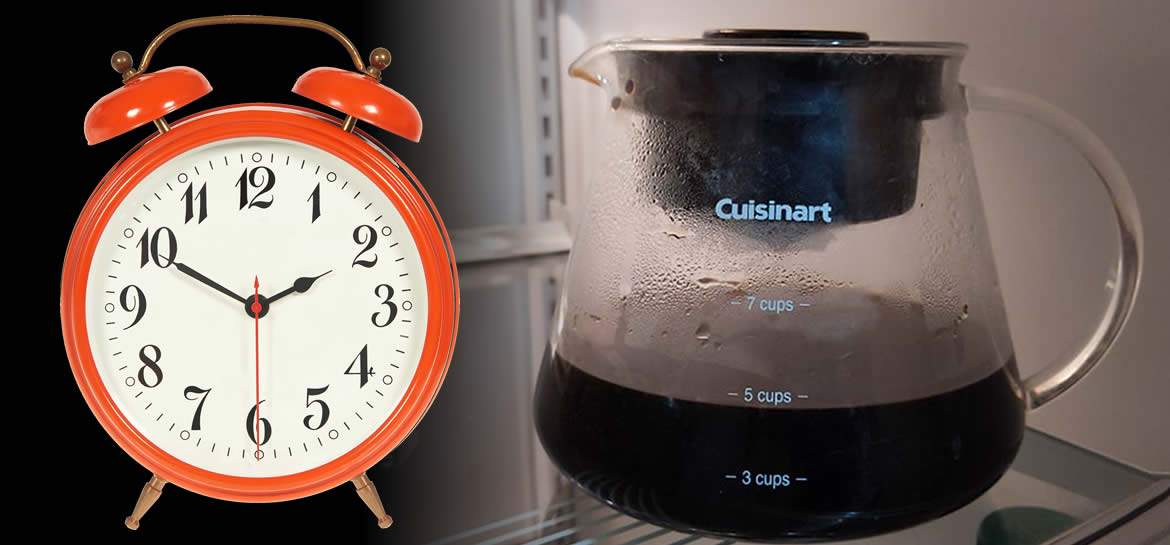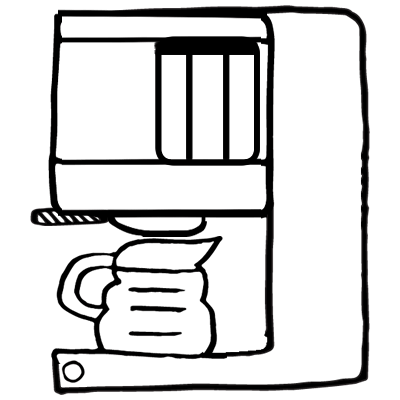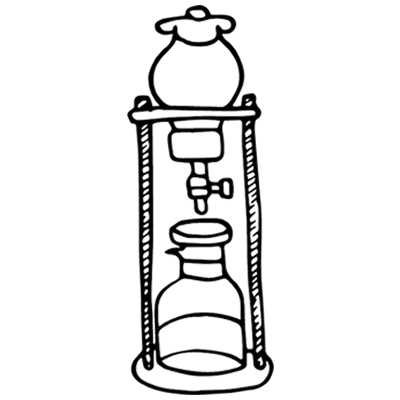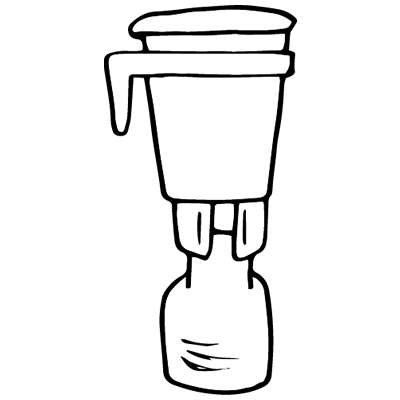Cold brew coffee is an effective and delicious way to enjoy a cup of joe in the morning. With this highly intuitive brew style, you can easily steep cold brew coffee the night before without compromising on freshness or flavor as you might with hot coffee.
Don't want cold coffee? No problem!
Cold brew allows for you to heat it up after brewing without sacrificing it's flavor.
A coffee lover, who usually makes hot coffee, may wonder how long you should steep cold brew coffee, but it is pretty straightforward. In fact, it is much easier than most people think as it doesn't require many steps.
Still, you might be wondering how long to soak cold brew coffee at home. Let's get into it.
We hope that by the end of this article, you will feel confident enough to make cold brew coffee with pride. If you love the results, please share your cold brew steep time and experiences in the comments section.
How Long Should I Steep Cold Brew Coffee?
One of the best ways to make cold brew coffee meet your specific palate is through trial and error. Each coffee enthusiast will prefer a different strength for their cold brew, and as such, you'll have to experiment with varying cold brew steep times for each type of cold brew method to get the results you want.
But what is the minimum cold brew time?
The minimum time for cold brew coffee brewing should be a little more than 12 hours and no more than 24 hours at room temperature for the most common brew method (immersion).

Still, in order to truly answer the question for "how long you should steep cold brew coffee," you'll need to first determine the method in which you are making your cold brew.
Immersion Cold Brew Method
If you are making cold brew in an immersion coffee maker, expect the best results from an 18-24 hour brew. Do not exceed 24 hours in an immersion brewer at room temperature.
Cool Drip Cold Brew Method
Cool drip, sometimes referred to as cold drip coffee brewers, generally take anywhere from 8-12 hours to complete the drip. This extraction process allows you to control the speed of the drip in some cases, but the extraction result should be close to the same as long as the drip occurs slowly (1 drip every few seconds).
Rapid Agitation Cold Brew Method
These new rapid agitation machines are all different, but the standard machines have settings from 15 minutes to 45 minutes, generally. I have found the milder settings to be inadequate for this extraction process, so I always choose the 45 minute brew or brew it twice at the 45 minute setting for a bolder extraction.

Cold Brew Steep Times
You may be wondering how long to let cold brew sit once you've added the grounds to your brewer of choice. Can you overbrew cold brew? We'll get to the bottom of these questions right now.
Cold Brewing your coffee for any longer than the recommended steep times may cause it to become bitter and woody and may affect caffeine content.
An essential rule of thumb to remember, if you plan to brew a standard strength brew, follow the manufacturer's instructions and only deviate if you don't enjoy the recommended solutions.
Keep in mind that different recipes call for different timings for cold brew. The longer the grounds remain immersed in water within the recommended timeframe; the stronger the coffee will become.
The 15 - 45 min Cold Brew Steep Time
If you've got a rapid agitation brewer, you'll enjoy faster brew times, but you are unlikely to extract enough caffeine or flavors for a cold brew concentrate.
While 15 minutes may appear fast, the quality of your brew suffers if you haven't allowed enough time for the water to absorb the grounds soluble elements.
Personally, I prefer running my rapid agitation brewer when I am very low on time or realize I ran out of cold brew just before an important meeting.

Note: Follow manufacturer instructions to achieve the best result.
The 8-hour Cold Brew Steep Time
If you're someone who is in a rush, you'll find that if you steep cold brew for up to eight hours, it will give you a similar flavor profile to an iced coffee without the bitterness(of course). While this is less than the recommended 12-hour steep duration, it is still useful for when you are short on time.
There are a few variables to consider when choosing the 8-hour method.
If you select a cool drip cold brew coffee system (cold drip coffee), the friction from dripping water will extract more from your grounds than with a standard immersion brew.
The difference is that the drip extracts only once, while immersion is a constant extraction.

Depending on the beans you use, you'll likely extract a little more nuance using this cool or cold drip coffee method over hot brewing. However, compared to the 12 and 18-hour methods, it won't be as rich or robust in flavor.
The 12-hour Cold Brew Steep Time
The vast majority of people find that allowing their cold brew to steep for at least 12 hours in room temperature water gives them the best results. It also gives them the ability to brew coffee the evening before, so that it's ready before leaving for work during the day.
Compared to other methods, you might find that this steeping time requires less effort and will easily fit into your schedule.
This method works best for cool drip systems as immersion brews need a bit longer to extract the right amount of flavors and caffeine from your chosen beans.

The 18-hour Cold Brew Steep Time
Most experts recommend to try steeping your cold brew for 16 hours, up to 18 hours in room temperature water, to determine if it creates the strength you'd expect if you prefer a stronger taste.
In my experience, immersing your coffee grounds for 12 hours or less won't make the coffee as round and robust as you might expect, especially if you are using an immersion brew system like a mason jar or Toddy.
When you reach the 18-hour mark, your brew will extract fewer soluble elements.
Can You Oversteep Cold Brew?
As we went over above, you most certainly can overbrew your batch. However, if you take some precautions, properly sanitize your brewing vessel and brew in the fridge, you can brew for longer than 24 hours.
There is a significant difference in flavor improvements between steeping cold brew 12 vs 24 hours, but after that, you run the risk of extracting sour and bitter flavors that most wish to avoid.
Recently, we did an experiment to see how long we could brew before the taste suffered.
36 hour Cold Brew Steep Time
Using a Toddy brewer, we attempted to steep our batch in the fridge for 2 days. But, we set a benchmark at 36 hours. The taste of cold brew 36 hours in is a little stronger than at 24 hours, but not significant enough to stop the experiment.
48 hour Cold Brew Steep Time
At 2 days, the flavor was there, and the brew very strong. I had to dilute it quite a bit, and I noticed a tinge of bitterness in the extraction. It was palatable, but I needed to know to what extent we could push it.
72 hour Cold Brew Steep Time
Since we first sanitized everything, we did not notice any weird growth after 72 hours, but the flavor was very strong and the taste bitter. I don't think I would recommend pushing a brew beyond this timeframe, but if you enjoy bitter coffee with a little more flavor nuance than iced, go for it. We stopped the experiment here though because it became something beyond what we wanted. If I wanted bitter coffee, I would hot brew. No thanks.
Note: The coffee to water ratio you choose will always affect the outcome.
Cold Brew Benefits
Plenty of people opt for cold brew coffee over hot coffee because it's more gentle on their stomach and more comfortable to digest. It also helps to eliminate the symptoms of heartburn, which can be uncomfortable to deal with throughout the day.
Aside from a lower acidic content, properly steeped cold brew coffee also has more subtle flavors without the harshness of bitter solubles. This distinction is especially crucial if you prefer a dark roast, as it's infamous for harsh flavors and acidic notes that will seep through when brewed hot or for longer durations.
Do not steep your brew for more than 24 hours at room temperature as this will produce more earthy and woody undertones that will not be pleasant.
The longer you submerge the coffee in the water, the more the bitter agents, such as chlorogenic acid found in coffee beans, will mix in with it. If you want a stronger concentrate, add less coffee to water ratio rather than soaking the brew for more hours.
Cold Brew FAQS
Now that you have a better idea of how long you should immerse cold brew coffee, I'm sure you likely have other questions too. Let's discuss some of the most popular items around cold brewing. Knowing as much about cold brewing as possible will help you to create the perfect coffee your first time around.
What Coffee Should I use to Make Cold Brew?
There are hundreds of different types of coffee that you can use to create a cold brew, though the most popular are those with fruity profiles.
You will want to consider African coffees if you prefer fruity and citrusy notes that are sweeter when drinking black coffee. If you prefer to add some sweetener and milk, Latin American coffee is preferred as it is more rooted in flavor.
Beginners may also experience some success with balanced blends as they have a combination of sweet and complex notes and share elements of both African and Latin coffees. These are easy to drink black or with added sweeteners.
Just make sure to use coarsely ground beans in your recipe.
You May Be Interested in:
Should I keep my Cold Brew Refrigerated?
It's easy to assume that once the brewing process is "complete," you can remove your cold brew from the fridge. However, I highly recommend that you keep it cold for as long as possible. If you made your cold brew concentrate at room temperature, once your steeping process is complete, immediately store it in the fridge or serve.
Leaving cold brew outside for longer than the required brewing process will cause it to go wrong sooner and result in a stale brew. Keeping your batch in the fridge will maintain the flavor profile and keep the coffee fresh if you go back for a second or third cup.
Does Cold Brew Stay Good for a Long Time?
Ideally, you should keep your cold brew in your refrigerator for no more than 14 days. You'll easily be able to tell if your coffee is starting to feel off, as it will smell and taste strange. A tip is to use cold brew coffee that has started to go off to water for your plants. Just make sure to dilute the coffee before watering your water pots.
Can I make Cold Brew in Less than 24 Hours?
Yes, there's very little pressure when it comes to choosing how long to steep coffee beans in your cold brew. Try steeping your coffee for anywhere between 12-20 hours.
If you are wondering how long to steep cold brew, you can always brew for up to 24 hours if in the fridge.
That said, steeping for longer than 18 hours and up to 24 hours may significantly change the taste of your batch.
Is Cold Brew Recommended for Decaf Coffee?
Yes definitely. You can brew the perfect cup of cold coffee with decaf coffee beans using the same brewing process.
It's important to remember that not everyone drinks cold brew for the buzz it delivers. There are plenty of people who simply enjoy the taste of coffee, and using decaf will unlock all of the flavorful elements of your favorite grounds.
What's the Recommended Grind for Cold Brew Coffee Makers?
You should always follow the manufacturer's instructions for grind size based on your specific coffee maker.
The most important thing when deciding on a coffee grind is the filtration the grounds will receive.
Ideally, you should achieve a coarse grind similar to what works best in a French press. This grind size will allow the grounds to filter nicely and still allow the coffee to steep in the water for a long time without dissolving entirely.
Coffee grounds that are too fine or small will result in a cloudy and particle-filled sludge brew and may produce a bitter taste as smaller grinds produce a higher acidity content.
Some cold brew systems may give you specific instructions as to the proper grind size for that maker. Always follow the instructions included in the manual to ensure the longevity of the machine, while making the best possible batch with it.
How Cold Should the Water be When Cold Brewing?
The majority of the "coffee-making magic" happens when you leave your brew to steep. The beginning temperature doesn't have much to do with the brewing process. For this, you can add warm or cold water. However, many have found that steeping at room temperature is the most efficient choice.
Another point to note is that you should use clean water for your cold brew. Just as the quality of ground coffee you use is essential, having clean filtered water will affect the outcome of your cold brew coffee.
What Type of Filters Should I use for Cold Brew?
Filters are quite crucial with cold brew, and there are plenty of variations available. Most at-home users rely on paper filters as they're the most accessible and the least expensive.
You may want to consider buying reusable wool filters. Wool filters are slightly more expensive, but with the proper care, they'll last a long time.
With wool filters, you will want to rinse them with hot water after every use, store them in a freezer bag, and freeze them. When you need to make another pot of cold brew, defrost the filter in warm water.
Metal filters such as a French press are also ideal for filtering, as they don't let sediments through when used with a coarsely ground coffee. Additionally, for larger batches with coarse ground coffee, you can use a sieve with tiny and tight holes with a cheesecloth layered over it to produce your own homemade filter.
What types of Coffee can I Make with Cold Brew Coffee?
There is an extensive drink menu you can make from your cold brew coffee batch. You can use cold brew coffee concentrate to make cold brew with cream, blended frappes, iced mocha coffees, and you can even heat your cold brew concentrate and add water to make something more traditional.
Depending on the taste and methods you prefer, you can be as creative as you like with additions such as flavor essences. Flavor additives like hazelnut, caramel, or French vanilla are excellent enhancements, or you can drink it black for that extra caffeine shot in the morning. Your cold coffee brew concentrate is also useful in many different dessert recipes as a tasty syrup or for a natural coffee flavor additive.
FINAL THOUGHTS
Many factors go into how to make cold brew coffee the best. The type of coffee beans you use are essential; however, knowing how long to steep cold brew is one of the most critical parts of creating the perfect cup or pitcher of coffee.
No matter however long to steep cold brew you choose, testing out brewing variations will help you find the ideal balance that suits your tastes.
My honest opinion is to try out the different cold brew steep times and methods to dial in your preference.
The next time you find a refreshing cold coffee brew on the menu, be sure to take notes and share them in the comments below. We love sharing recipes and brew methods with the community!

I would like to know if a recirculating system will work. If I submerge my coffee and recirculate the solution at a very slow rate will this reduce my brew time and give me the quality as a 12 to 24 hour brew time.
Thank you.
Frank, great question! I’ve actually seen quite a few hybrid agitation models use this method for shortening the cycle for immersion. I suppose recycling your first extraction through again at a slow rate would mimic the agitation method by keeping a turbulent friction between the water and coffee grounds. I think there are examples of brewers out there that do something similar, but it seems that most products focus on 45 minutes or less. I’d be interested to learn how your experience goes, just make sure you use food-grade pumps and hoses if you plan to experiment with it.
Try doing this scientifically. Make the first attempt a full length extraction up to 24 hours. Then, try half time, quarter time, 3 hours, 1 hour, 15 minutes. See what the differences in flavor and caffeine concentration feel like with each and document it.
Also, if you come up with a working prototype for recycling your brew in this way, I’d be interested in trying it out.